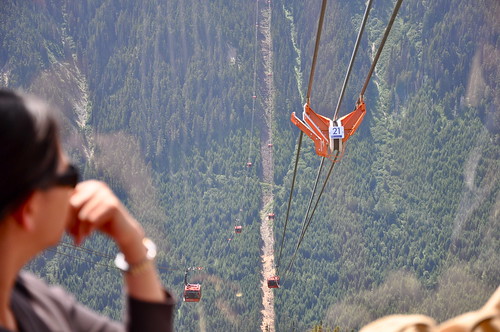In yesterday’s post, I alluded to the bizarre nature of term “3S.” Let me explain – and I warn you, this will make your head hurt:
The cable industry differentiates technologies like Monocable Detachable Gondolas (MDG) and Bi-Cable Detachable Gondolas (BDG) based upon the ropes/cables used. Great, you say. That makes sense. Monocables use one cable and Bicables use two. I get that. Problem is, the terms Monocable and Bicables are not used in that way.
For example, this is a Monocable Detachable Gondola:
And this is a Bicable Detachable Gondola:
Still, this seems straightforward enough. In the pictures, Monocables use one cable and Bicables use two. No big deal. Here’s where things get odd though. In the cable industry, Monocable is used to describe a vehicle whereby one cable is used for both support and propulsion. This is why Funitels are often referred to as Double Loop Monocables. Despite appearing to use two different cables, a Funitel only uses one rope and uses it for both support and propulsion.
Bicables, on the other hand, are classed according to the principal that systems must have one rope (or set of ropes) for support and a second rope for propulsion. That means the 3S, which is named for having three ropes (two support ropes, one propulsion rope) is actually classed as a BDG system. This is why on websites like Lift-World you won’t actually find 3S systems in their database. You actually have to dig through the BDG database to find them.

Despite clearly using three ropes (and being named for those three ropes) the 3S is still classed as a Bicable system. Image by Derek K. Miller.
In other words, the terms Monocable and Bicable are both a reference to a specific technology and a reference to a group of technologies. Problem is, the references are highly misleading; do not conform to the common logic of counting the number of cables we see; and cause obvious confusion.
As I’ve mentioned before (here and here), cable nomenclature is complex and difficult when first encountering the technology. But the way in which sub-technologies and systems are grouped and classified are positively arcane and borderline ridiculous. This is a problem for the industry because it needlessly complicates already expensive and time-consuming planning research. If I want a Bus or Streetcar or Light Rail or Subway, I don’t have to worry about families, sub-groups and the like. I just ask for a Bus or a Streetcar or a Subway. It’s simple.
Worse still is the common occurrence of researchers and writers using the qualities (or lack thereof) of one cable technology to mistakenly discredit cable as a whole without actually understanding that there are huge differences between cable techs and the bizarre manner in which their organized.
Told you it’d make your head hurt.




1 Comment
Yeah, I’ve never ever seen people disagree about the borderline between Light Rail and Streetcar. Oh wait…
😉